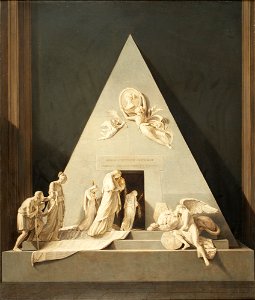Catalogue entry:
this painting was submitted to the paris salon of 1833 by the little-known painter charles swagers. The cenotaph depicted here stands in the augustinian church in vienna; commissioned by duke albert of sachsen-teschen to commemorate his wife, who died in 1798, it was created by antonio canova (1757–1822), the foremost neoclassical sculptor of the age. Like the monument canova had designed earlier to honor titian, in venice, it was unprecedented for its synthesis of an ancient structure — based on the pyramid of cestius in rome — and a modern interpretation of a figural tomb. The deceased appears only in a portrait medallion, and christian imagery has been eliminated. The genius of death, the mourning lion, the figures representing the different ages of humankind: all suggest an eternity and a visual language that would have been as comprehensible to the ancients as they are to us. Gallery label:
this painting depicts the tomb that albert of saxe-teschen commissioned from canova for his wife, maria christina of austria. The monument, in st. Augustine’s church in vienna, was completed in 1805. The painting differs from the monument in its inscription, which reads "mariae christinae avstriacae/ alberti saxoniae principis conivci" (to maria christina of austria/ wife of albert, prince of saxony) instead of the original "vxori optimae /albertvs" (to the best wife/albert). This change reflects the different intentions of the sculptor and patron. Albert had envisioned the monument as a traditional homage to the deceased, but canova created a new kind of monument, in which the theme of death itself was emphasized: a cortege of people of different ages and genders enters the doorway of the royal tomb, which becomes a gateway for all of humanity to the world beyond. Object Type: painting. Date: 1820s. Place of creation: France. Dimensions: height: 73 cm (28.7 in); width: 61.5 cm (24.2 in); frame: height: 90.2 cm (35.5 in); width: 79.7 cm (31.3 in); depth: 7.3 cm (2.8 in). Medium: oil on canvas. Collection: Princeton University Art Museum. Swagers, Charles, The Tomb of Maria Christina of Austria, by Antonio Canova, 1820s
Loading...
